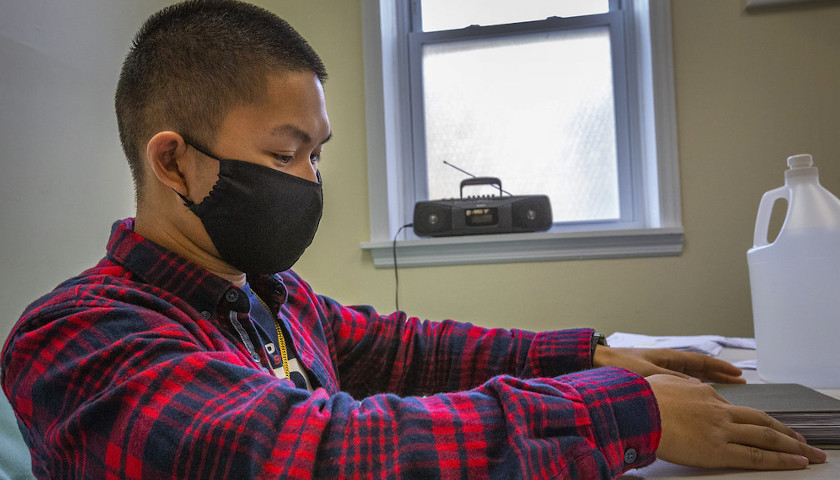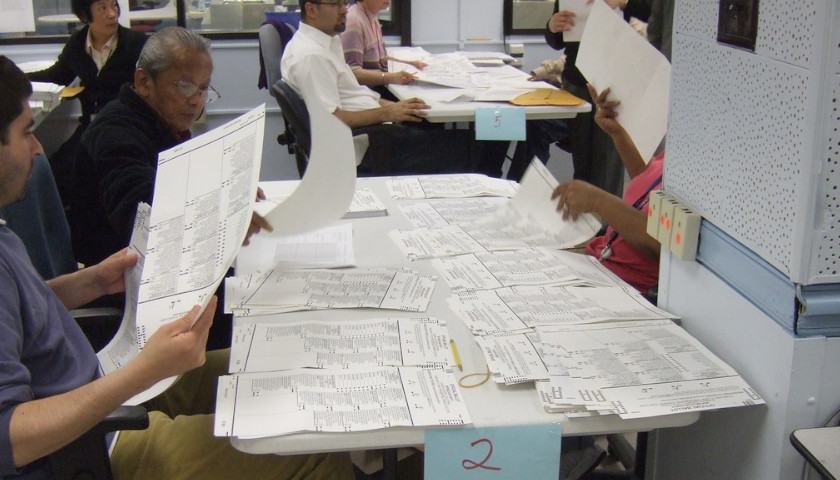Two representatives from True the Vote, the election integrity organization whose work using GPS smartphone data to investigate ballot harvesting in Arizona and other states was featured in the recent 2,000 Mules documentary by Dinesh D’Souza, testified during an Arizona legislative hearing on Tuesday providing further details. Catherine Engelbrecht, the founder and president, and Gregg Phillips, a data expert, drew frequent gasps and applause, despite a request at the beginning for no clapping. When asked by legislators what Engelbrecht recommended for action, she said to pass HB 2289. Sponsored by State Representative John Fillmore (R-Apache Junction), it bans drop boxes and has passed the House but has been held up in the Senate.
Democrats in the legislature tried to interfere with the hearing by forcing a vote on a gun control bill, stalling it for well over an hour. Right Side Broadcasting filmed the hearing live on YouTube, but it was yanked by YouTube by the time it was finished.
State Representative Shawnna Bolick (R-Phoenix), a champion of election integrity who is currently running for secretary of state, arranged the hearing, which was also hosted by State Senator Kelly Townsend (R-Apache Junction) and included several other legislators. The documentary 2,000 Mules found that several hundred ballot harvesters, or mules, appeared to have illegally transported thousands of harvested ballots in Maricopa and Yuma Counties during 4,242 trips during the 2020 election.
Townsend asked Engelbrecht if the names of the nonprofits that were implicated would be released. Engelbrecht said they could not since it could interfere with law enforcement’s investigation. She named Pinal County Sheriff Mark Lamb, who was in the audience, as already working with them investigating.
Townsend called for any whistleblowers to come forward now, “save yourself a little grief.” Engelbrecht responded and said many whistleblowers have come forward already. She said The New York Times is about to publish an article claiming that the whistleblower from San Luis, Arizona, who was featured anonymously in the documentary, was an actor, but she said the woman is already talking to the AG’s office.
Engelbrecht testified that in some communities, it is expected to submit your ballot before it’s sealed to a nonprofit. Phillips revealed that they tracked 4,242 trips by mules in Arizona.
Engelbrecht explained how easy it is to track smartphones. She said to go to the keypad and type *#06# and then hit the green or send button. It shows the identification codes associated with the phone that advertisers use, she said, this is how a store knows to show you ads on your phone when you are nearby, and how law enforcement identifies suspects. She said the Times ran a series of seven articles explaining this technology in 2019.
Phillips pushed back on some of the mainstream media’s criticisms of 2,000 Mules. He said they weren’t merely triangulating around signals between cellphone towers. Just like the Times, they obtained signals that are stamped with latitude and longitude and maybe even altitude, and mapped them with time stamps. There’s even more information provided in smartphones to identify them, known as MAID, which they can access. He said one key way they add certainty is by comparing birthdates – someone can have similar information to another person, but when they add the birthdate it brings far more certainty.
The kind of work they do to trace people is already being done by law enforcement like Sheriff Lamb. He said they obtain records from three different sources to identify a cellphone signal, not just relying on one, in case there’s a false positive. They kicked out 40 signals in Phoenix for this reason. This was far more thorough than how the Justice Department tracked the Jan. 6 participants, he said, since they only relied on one source of data from Google.
Phillips said “journalistic terrorists” criticized their work by saying they could be identifying someone on the wrong side of the street, but he said they’re far more accurate than that. The media also said they only got within 100 feet of drop boxes, which was also inaccurate. “It’s like magic to The Washington Post,” Phillips said about the newspaper’s skepticism.
The military can pinpoint someone using this technology up to two centimeters. Engelbrecht said Chief Justice John Roberts stated in an opinion, Carpenter v. U.S., that the government can track people down to the level of an ankle bracelet. That decision laid out the law for how far both the government and civilians can go in using this type of information, which True the Vote has used as a guide. Engelbrecht compared it to how Uber can find someone’s location.
Engelbrecht said they only identified drop box visitors as mules if the person stopped by a drop box at least 10 times, and stopped by a nonprofit several times. The mules in Arizona dropped by drop boxes an average of 21 times. Engelbrecht said one smartphone alone had 77 unique drop box visits in Yuma County. Phillips added that 71 times they counted the presence of three mules in a nonprofit at the same time. Engelbrecht said they traced one mule to the Georgia runoff election later.
Engelbrecht said the reason they decided to look into ballot drop boxes was because they were relatively new in voting; there weren’t a lot of rules and regulations yet, so it was ripe for fraud. The prevalence of outdated voter rolls combined with sending out massive amounts of ballots created an opportunity.
Phillips said the attitude regarding election law of “substantial compliance” is flawed. It should be to follow the law that is in place at that time. He brought up a 1994 election case from his home state of Alabama, where Alabama Chief Justice Perry O. Hooper Sr. went to bed on election night believing he had won by 15,000 votes. But when he woke up the next morning, he found he had lost to the Democrat due to a flurry of last-minute ballots that came in, many with no date and no signature. He sued to get the improper ones excluded, and the Supreme Court ruled in his favor and he won by 262 votes after several recounts.
Unfortunately, True the Vote was unable to get much surveillance video from the Yuma County drop boxes, Engelbrecht said. She suggested this could violate the law, since video from federal elections must be retained for 22 months. Maricopa County gave them video of one drop box, but it was obscured behind a tent.
Bolick expressed her concern that she was given a tour of Maricopa County Elections prior to the 2020 election by then-Maricopa County Recorder Adrian Fontes, a Democrat, “who told us things and showed us things that didn’t add up.” She expressed her frustration that even though the legislature introduced over 100 election integrity bills this session – and across the entire country apparently only 300 have been introduced – almost none are passing due to a couple of Republican legislators voting with the Democrats.
State Representative Tim Dunn (R-Yuma) suggested that if the legislature is unable to get HB 2289 passed, people should hire rent-a-cops to monitor ballot drop boxes around the state. He said there is news coming out of Yuma about some nonprofits, and more prosecutions are about to start in multiple counties.
State Representative Quang Nguyen (R-Prescott) asked if the data had been turned over to the Arizona Attorney General. Phillips said it had been provided a year ago, but there had been confusion and that he would be meeting with some representatives from the AG’s office the next day. He said they are also turning over the data to the FBI. “The only thing I want to see coming out of this meeting is people going to jail,” he declared to massive applause.
Townsend said someone from the original Maricopa County ballot audit is investigating a flurry of last-minute voter registrations before the 2020 presidential election, resulting in incidents where there were duplicate ballots issued and the new one was cast but not the original, and then the new one immediately disappeared. She said there will be some follow-up comparing the data to some work State Representative Sonny Borrelli (R-Lake Havasu) did showing a lack of chain of custody with many ballots.
Townsend lamented how the legislature couldn’t even get a law passed requiring different usernames and passwords for elections staff accessing voting equipment, so she asked the legislators who voted “no” to put their personal usernames and passwords on her desk since they didn’t think it was a problem. Predictably, no one did, she said.
State Senator Sine Kerr (R-Buckeye) said the Yuma County Sheriff is already investigating new voter registration fraud for the upcoming 2022 election, and Phillips responded saying they received video from someone today about it.
Phillips said the day 2,000 Mules came out, the opposition went after them so hard they got Mississippi State University to cancel their lease.
Engelbrecht told the legislature she recommends four steps:
- Take a deep look at accuracy of voter rolls; use real-time technology to keep them updated, something the private sector would have no problem doing. There is no reason that can’t be done today. The U.S. is lagging behind the rest of the world in election technology.
- Stop the mass mailout of ballots, especially combined with dirty voter rolls.
- Stop using ballot drop boxes, or secure them with real-time video surveillance.
- Make the penalty for cheating something that cheaters fear.
– – –
Rachel Alexander is a reporter at The Arizona Sun Times and The Star News Network. Follow Rachel on Twitter. Email tips to [email protected].





